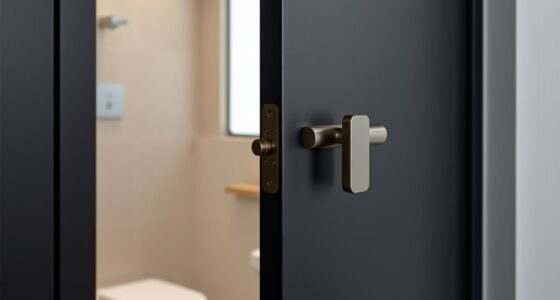To improve bathroom accessibility, install sturdy grab bars near the toilet and shower, securely anchored into wall studs, and use corrosion-resistant materials. Make certain there’s enough space—at least 32 inches wide doorways and a 5-foot turning radius for wheelchairs. Incorporate slip-resistant flooring, accessible fixtures at appropriate heights, and lever handles for easier use. Thoughtful features like high contrast colors enhance safety for all users—discover more ways to create a safer, inclusive bathroom.
Key Takeaways
- Install grab bars securely into wall studs and position them within easy reach for support.
- Ensure doorways are at least 32 inches wide and leave adequate clearance for wheelchair maneuvering.
- Use slip-resistant flooring and proper lighting to reduce fall risks and improve visibility.
- Place fixtures at accessible heights and use lever handles for easier operation from a seated position.
- Incorporate high contrast colors and safety features to enhance inclusivity and meet accessibility standards.

A accessible bathroom is crucial for ensuring everyone can use the space comfortably and safely. When designing or upgrading a bathroom, one of the most important features you can add is grab bar installation. Grab bars provide sturdy support, helping individuals maintain balance and prevent falls, especially when getting in and out of the shower or toilet. Properly placed grab bars are essential for those with limited mobility or balance issues, offering confidence and independence. When installing grab bars, consider placement carefully; they should be within easy reach and positioned vertically or horizontally based on specific needs. Secure anchoring into wall studs ensures maximum stability, preventing accidents caused by weak or improperly mounted bars. Don’t forget to choose corrosion-resistant materials, especially in humid environments, to guarantee longevity and safety.
Wheelchair maneuvering is another critical aspect of bathroom accessibility. If someone uses a wheelchair, the space must accommodate smooth, easy movement. This means designing the layout with ample clearance around fixtures and ensuring doorways are wide enough—generally at least 32 inches—to allow easy wheelchair access. When planning the space, think about the turning radius needed for a wheelchair, which is typically 5 feet in diameter. Clear floor space should be maintained to facilitate effortless turning and maneuvering. Installing fixtures at accessible heights also makes a significant difference; for example, placing the sink and toilet at heights that are reachable from a seated position helps users independently perform daily tasks. Additionally, consider the placement of grab bars near the toilet and shower to assist with transfers, further enhancing safety and independence.
You should also evaluate the flooring material to prevent slips and falls, especially when wet. Non-slip tiles or mats can dramatically improve safety, reducing the risk of accidents for everyone. Lighting plays a vital role, too—bright, even lighting helps users see clearly, avoiding hazards. Incorporating lever-style handles instead of knobs on faucets and doors simplifies operation for those with limited hand strength. When you combine these features—grab bar installation, thoughtful layout for wheelchair maneuvering, slip-resistant flooring, and accessible fixtures—you create a bathroom that’s safer, more functional, and welcoming for all users. Making these adjustments not only complies with accessibility standards but also demonstrates a commitment to inclusivity, ensuring everyone can enjoy the bathroom without anxiety or difficulty. Additionally, utilizing high contrast color schemes can further aid individuals with visual impairments in navigating the space safely.
Frequently Asked Questions
What Are the Costs Associated With Bathroom Accessibility Modifications?
Bathroom accessibility modifications can cost anywhere from $1,000 to over $10,000, depending on your needs. You should do a cost estimation early to help with budget planning. Factors like installing grab bars, widening doorways, and adding ramps influence the overall expense. By understanding these costs upfront, you can guarantee you’re prepared financially and make informed decisions to create a safer, more accessible bathroom space for everyone.
How Long Does It Take to Retrofit a Bathroom for Accessibility?
You can expect a bathroom remodeling project for accessibility to take anywhere from a few days to several weeks, depending on the scope of work. The accessibility timeline varies based on factors like existing bathroom layout, necessary modifications, and contractor scheduling. To guarantee a smooth process, plan ahead and discuss your needs with your contractor. Typically, a straightforward retrofit might be completed in 1-2 weeks, while more extensive remodels could take longer.
Are There Specific Building Codes for Accessible Bathrooms?
They say “better safe than sorry,” and that’s true for accessible bathrooms. Yes, there are specific building codes you need to follow. Building code compliance guarantees your bathroom meets accessibility standards, like proper door widths, grab bar placement, and maneuvering space. Check local regulations, as these standards can vary. Staying compliant not only keeps you legal but also makes your bathroom safer and more inclusive for everyone.
Can Portable Accessibility Solutions Be Effective Temporarily?
Yes, portable accessibility solutions can be effective temporarily. You can use portable devices like foldable ramps, mobile grab bars, and portable toilet seats to enhance bathroom accessibility during renovations or emergencies. These temporary solutions are versatile, easy to install, and cost-effective, providing immediate support where permanent modifications aren’t feasible. While they may not replace permanent upgrades, they markedly improve safety and independence for users in the short term.
What Grants or Funding Options Are Available for Accessibility Upgrades?
Did you know nearly 2 out of 5 adults with disabilities face bathroom accessibility issues? You can explore various grant opportunities and funding sources to support upgrades. Local government programs, state-specific grants, and federal initiatives like the ADA Accessibility Grants are valuable options. Applying for these funds can help you make necessary modifications without straining your budget, ensuring everyone can access your bathroom comfortably and safely.
Conclusion
By making bathroom accessibility a priority, you’re opening a door to independence and comfort for everyone. Think of your bathroom as a bridge, connecting people to confidence and dignity. When you implement simple improvements, you’re not just making a space more functional—you’re building a path that welcomes everyone with open arms. Every small change you make is a step towards a more inclusive world, where no one feels left behind.









